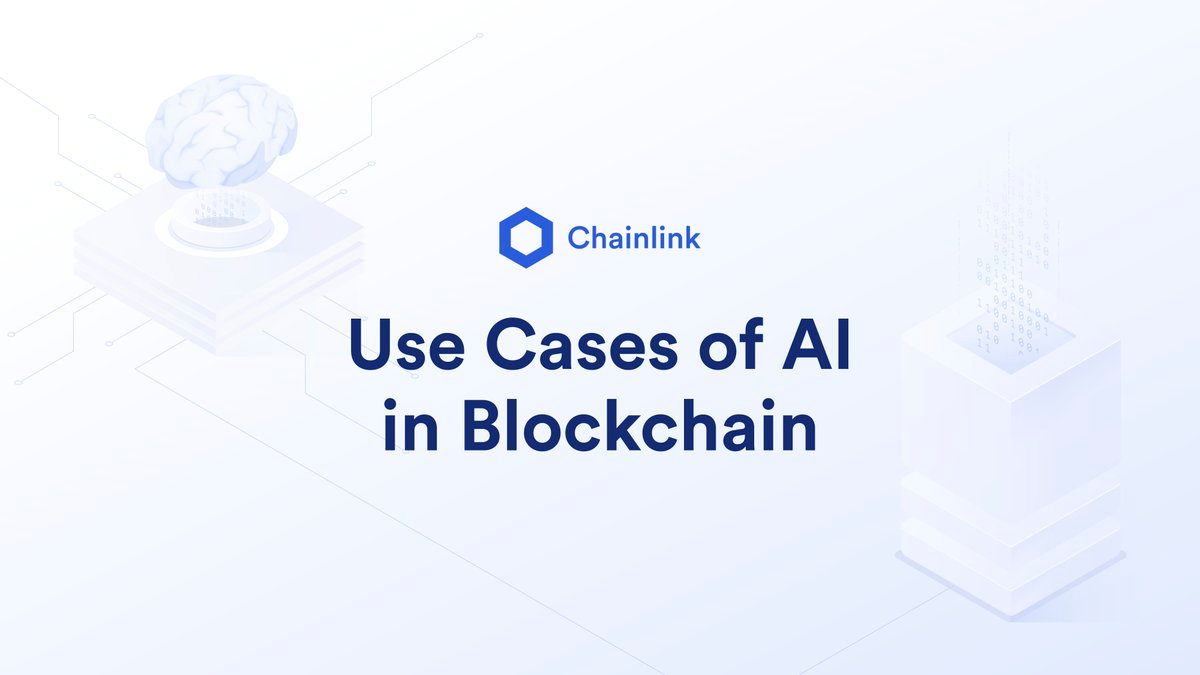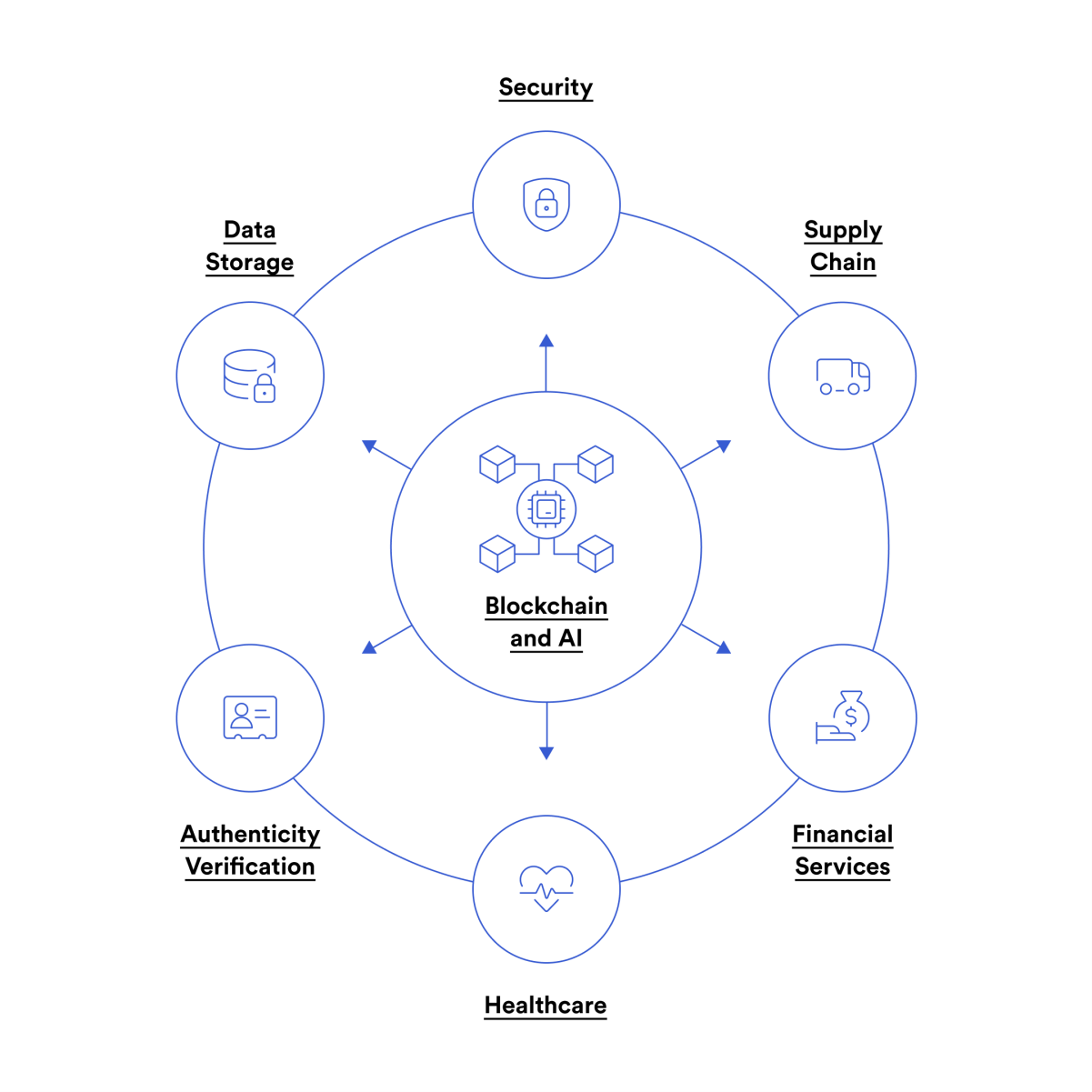
AI andblockchainThese are two of the most disruptive technologies of our time, with the potential to set off a revolution in innovation across multiple industries and completely overturn economic and social relationships. The combination of blockchain and AI will unlock new application areas. AI will greatly increase productivity, while blockchain can ensure security and transparency, so it will give birth to various innovative applications.
according toReported by Spherical InsightsThe combination of blockchain and AI will develop into a billion-dollar industry in the next ten years. How these two technologies work together, however, is still an understudied question, so it's worth exploring.
first level title
The intersection of AI and blockchain
Deep learning models are good at processing big data, simulating the cognitive process of the human brain, and using complex neural networks to identify patterns, make predictions, and make decisions. The blockchain network has a transparent, decentralized and anti-manipulation transaction settlement layer, which is available when connected to the Internet, and data stored on it cannot be tampered with, and users can use it without permission andtrust minimizationway to interact with the blockchain.
The combination of blockchain and AI will give birth to an automated intelligent decision-making system that outputs very reliable results and triggers operations in the real world based on tamper-proof data.
The combination of blockchain and AI will unlock a new business model, improve operational efficiency for enterprises, automatically complete repetitive tasks for individuals, exchange data more securely and efficiently, enhance decision-making processes through AI smart contracts, and improve key infrastructure and Trust and transparency in the transaction process.
image description

first level title
Use cases where AI and blockchain combine
secondary title
security
Decentralized infrastructure and blockchain technology can provide cryptographic security for AI systems. We can embed safety barriers in the AI system to prevent the system from being abused or maliciously manipulated. AI developers can set specific parameters in the code to control the threshold of AI access to various key systems; they can also use blockchain, smart contracts andOracleCreate a private key mechanism for tamper-proof infrastructure.
The original intention of the blockchain system is to prevent various malicious attacks and manipulations, and these security mechanisms can also be used to prevent attacks in the AI field. In a centralized system, as long as there is a problem in a certain link, the security of the entire system may be threatened; while the decentralized infrastructure is distributed to multiple nodes and multiple independent private keys, so it is more difficult for attackers to invade the entire system. system.
Blockchain can effectively improve the security of AI applications, so enterprises can fully realize the potential of AI and passEncryption Technologysecondary title
Track the supply chain
smart contractIt is a computer program deployed and run on the blockchain, and the code in the contract specifies the trigger conditions and the results of the trigger. Smart contracts can be executed automatically, so they have special advantages when combined with AI. The AI model is connected to the smart contract, and specific conditions can be predefined to perform tasks, such as: monitoring the inventory situation, and automatically placing an order with an external supplier when the inventory is insufficient.
The combination of blockchain and AI can also digitize paper-based processes and monitor every link from production to delivery in real time to improve transparency and reduce the risk of fraud. Combining the predictive analysis capabilities of AI with the blockchain, enterprises will be able to better understand demand patterns, optimize inventory management, and make decisions based on data to reduce costs.
secondary title
Verify the authenticity of the content
The emergence of deep learning models such as DALL-E, Stable Diffusion, and Midjourney has demonstrated the unlimited potential of generating images or other media from text.
While these models allow us to see the disruptive innovation potential of AI for productivity and creativity, they could also be used to spread false rumors or fake images or other communication mediums.
The bottom layer of blockchain technology is cryptography and encryption technology, so it can be used to verify the authenticity of media such as images, videos, and text, and encryption technology is used to verify the source of content and whether the content has been tampered with. This cryptographic watermarking technique can also be used to create tamper-proof timestamps that verify the authenticity of message content, origin and time.
To ensure social stability in the future, we must be able to distinguish between AI and human-created content. Therefore, cryptographic verification and timestamps can be used to assist decentralized platforms to display, verify and distribute content. Such platforms can also help creators and users build trust in content, ensuring that the medium of information dissemination has not been tampered with, is authentic, and that all historical records are transparent and verifiable.
In addition, on-chain certificates, especiallyNFT, which can effectively solve the problems faced in verifying the authenticity and traceability of digital content. NFT is a unique digital asset that can be used to represent asset ownership and verify images, videos, text andmusicsources of various documents.
secondary title
analyze data
The greatest value of blockchain technology is that it can most efficiently guarantee the authenticity of data sources. To ensure data integrity in the long run, the best way is to store data in a highly secure decentralized blockchain network. Therefore, the blockchain is naturally a good big data analysis platform.
As the blockchain increasingly dominates human social and economic activities, the use of complex machine learning models for big data analysis can also handle massive data sets on the chain. These machine learning models can identify megatrends and output useful insights through predictive analytics. This can help companies and individuals make efficient and rational decisions and judge emerging opportunities in the on-chain economy.
secondary title
Provide financial services
haveDecentralized Finance (DeFi), anyone with an Internet connection can access transparent financial services, carry out peer-to-peer transactions, and interact with immutable smart contracts. The DeFi ecosystem has made great progress, and AI models can use these increasingly rich and mature DeFi financial services to perform operations and tasks based on predefined instructions, and conduct transaction settlement.
If a large language model can be safely connected to the Internet, it can also be connected to Web3's on-chain financial technology stack to perform routine tasks such as payment or transactions. Since the blockchain application itself hasComposability, AI models can execute interrelated complex financial transactions without relying on any intermediaries and opaque traditional financial systems.
secondary title
Provide healthcare services
Some blockchains are well-suited for storing sensitive data, and advanced AI models can use this to analyze health data and identify recurring patterns and make accurate diagnoses based on medical photos and medical records. in addition,homomorphic encryptionInnovative encryption technologies such as cryptography can also perform operations on data without revealing data privacy.
AI and blockchain technology can safely store and share medical records, medical research data and other sensitive data, thereby improving the management level, privacy and security of medical data. Researchers in the fields of healthcare and longevity will be able to collaborate more effectively in remote locations with maximum data security.
secondary title
Ensure transparency
One of the challenges that current deep learning models face is that the decision-making process is opaque. Because these models are very complex, sometimes with hundreds of billions of parameters, soIt is difficult for experts to explainWhy a model outputs a specific answer to a specific question.
While this opacity is a fundamental characteristic of deep learning models, and it is ultimately the job of AI researchers to develop AI models that can explain their own decisions, blockchain networks can take advantage of their transparency to some extent to address The problem of AI model opacity.
secondary title
Decentralized Data Storage
Many AI models rely heavily on large datasets. While data is only one element, it can greatly affect the performance of an AI system. Blockchains such as Filecoin, IPFS, and Arweave can provide decentralized storage solutions, effectively guarantee the quality of training data and accurately trace data sources. In addition, as mentioned above, innovative encryption techniques can also provide encrypted data sets for deep learning models while protecting data privacy.
secondary title
Develop smart contracts
With the emergence of AI-assisted development tools such as Github Copilot, the efficiency of smart contract developers has been greatly improved. In addition, it is also possible to integrate AI-driven API interfaces in smart contract applications, analyze real-world sensor data or user sentiment on social media, or create generative models. And these will eventually promote the development of a new generation of Web3 applications. In this demo, Laurence Moroney, head of AI at Google, shows how to use Stable Diffusion andChainlink FunctionsDevelop an AI art generator for smart contracts.
Youtube video:https://www.youtube.com/watch? v=kG-ODpYRREQ
AI can also help game developers create entire game worlds, in-game assets, NPCs, and game script events to unlock brand newWeb3 gamesfirst level title
Challenges and considerations of AI combined with blockchain
Although the combination of AI and blockchain technology can bring many benefits to many industries, there are still some challenges to be overcome to truly unleash the potential of both. AI models have always faced a problem with collecting data, because they must feed into multiple different data sets. To perfectly combine AI and blockchain, it is necessary to solve the interoperability problem between the two platforms and establish standards to enhance the connectivity and compatibility between the two technologies.
In addition, the data privacy framework needs to be upgraded to solve the problems encountered in the integration process of AI and blockchain, and to protect user privacy and trust.
While both technologies have the potential to reshape the very foundations of society, public awareness of them is currently low. If the benefits, risks and precautions of the combination of AI and blockchain technology can be popularized to the public, it will make everyone more confident in the combination of blockchain and AI technology and improve user demand.
first level title
The Future of AI and Blockchain
The advantage of AI is large-scale intelligence, whileWeb3The advantages are large-scale coordination, value exchange, and trust minimization. So when the two are combined, it will open the door to a new world, bringing higher security, transparency and efficiency to many industries.
The combination of AI and blockchain will have a huge disruptive impact on various industries. As more and more companies begin to use AI-integrated software to automate workflow, improve efficiency, and optimize business, AI models will continue to enter more market segments.
At the same time, as public trust in institutions has waned in recent decades, users have also increasingly opted for apps with encryption guarantees. The convergence of these two paradigm shifts is poised to reshape the way societies and economies function.